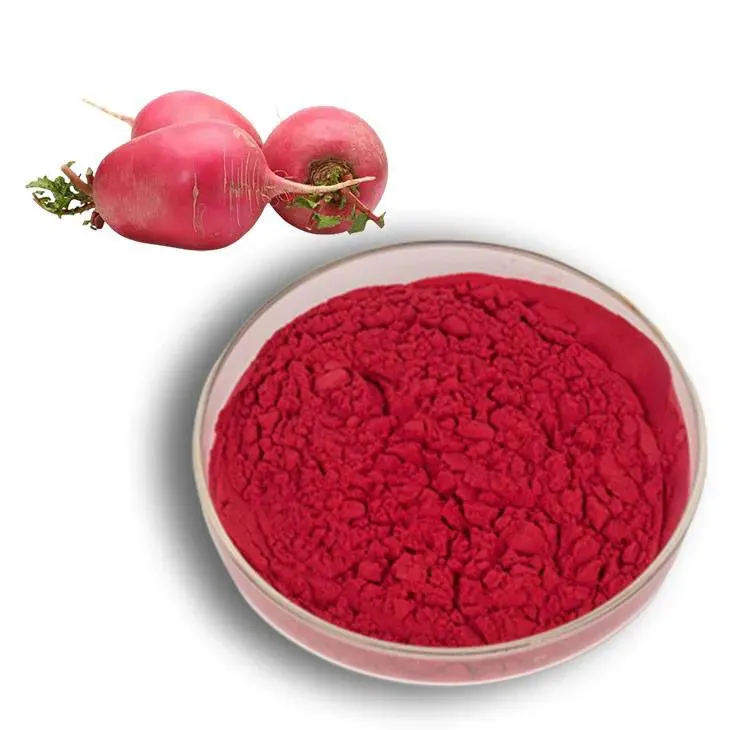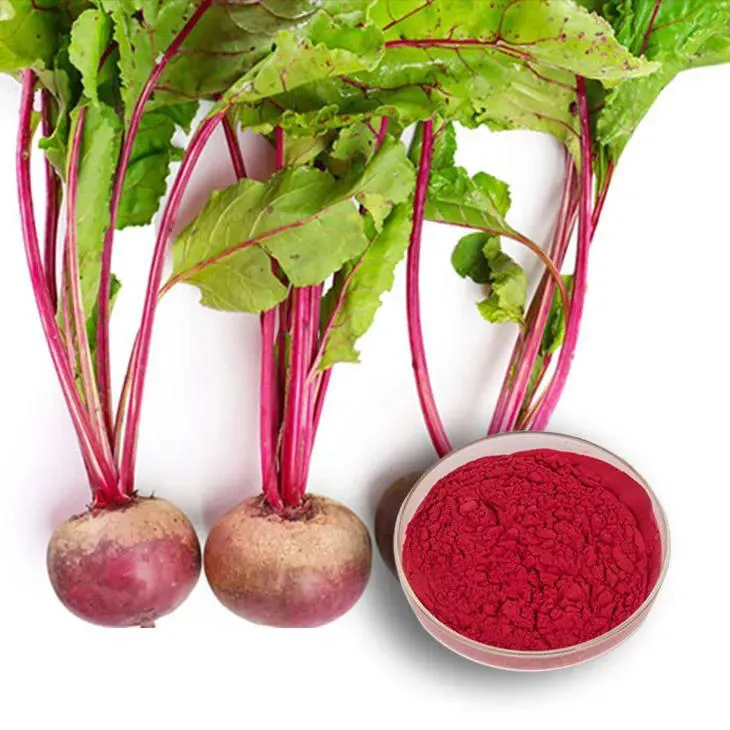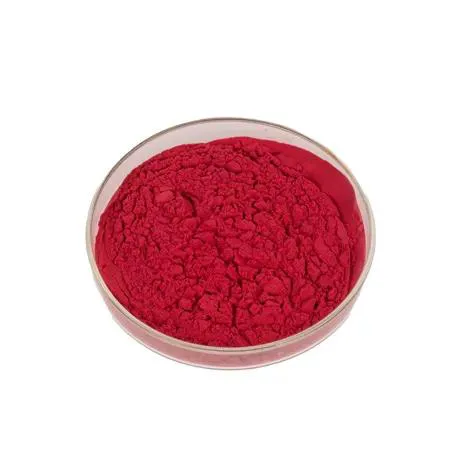- 0086-571-85302990
- sales@greenskybio.com
Transform Your Health with Homemade Beetroot Juice Powder: A Step-by-Step Tutorial
2024-08-02

Introduction
Beetroot is a nutritional powerhouse that has been associated with numerous health benefits. From improving heart health to enhancing athletic performance, beetroot offers a wide range of advantages. One of the most convenient ways to incorporate beetroot into your diet is by making your own Beetroot juice Powder at home. In this tutorial, we will guide you through the process step by step, so you can unlock the potential of beetroot for better health.

Benefits of Beetroot
Before we dive into the process of making Beetroot juice Powder, let's first explore the many benefits of beetroot:
1. Heart Health
Beetroot is rich in nitrates, which are converted into nitric oxide in the body. Nitric oxide helps to relax blood vessels, reducing blood pressure and improving blood flow. This, in turn, can lower the risk of heart disease and stroke.
2. Improved Athletic Performance
The nitrates in beetroot can also enhance athletic performance. By improving blood flow and oxygen delivery to the muscles, beetroot juice has been shown to increase endurance and reduce fatigue during exercise.
3. Anti - Inflammatory Properties
Beetroot contains betalains, which are powerful antioxidants with anti - inflammatory properties. These compounds can help to reduce inflammation in the body, which is associated with a variety of chronic diseases, such as arthritis and diabetes.
4. Digestive Health
The fiber content in beetroot can promote healthy digestion. It can help to prevent constipation, improve bowel regularity, and support the growth of beneficial gut bacteria.

Ingredients and Equipment Needed
To make Beetroot juice Powder at home, you will need the following ingredients and equipment:
Ingredients:
- Fresh beetroots: Choose firm, unblemished beetroots with their tops still attached if possible. The tops can also be used in other recipes or juiced along with the roots.
- Lemon juice (optional): Adding a small amount of lemon juice can help to preserve the color of the beetroot juice and add a touch of acidity.
Equipment:
- Juicer: A good quality juicer is essential for extracting the juice from the beetroots. You can use either a centrifugal juicer or a masticating juicer.
- Dehydrator: A dehydrator is used to dry the beetroot juice into a powder. If you don't have a dehydrator, you can use an oven set to a very low temperature.
- Blender or food processor: Once the dried beetroot juice has been removed from the dehydrator, you will need a blender or food processor to turn it into a fine powder.
- Fine - mesh sieve or cheesecloth: This will be used to strain the beetroot juice before dehydrating it to remove any pulp or solids.

Step - by - Step Tutorial
1. Prepare the Beetroots
- Start by washing the beetroots thoroughly under cold running water to remove any dirt or debris. Leave the skins on as they contain valuable nutrients.
- Trim off the tops and tails of the beetroots, but keep the tops if you plan to use them for other purposes.
- Cut the beetroots into small pieces that will fit easily into your juicer. You can either cube them or cut them into slices.
2. Juice the Beetroots
- Feed the prepared beetroot pieces into your juicer, following the manufacturer's instructions. If you are using a centrifugal juicer, you may need to cut the pieces into smaller sizes.
- If desired, add a small amount of lemon juice to the beetroot pieces as they are being juiced. This will help to preserve the color of the juice and add a bit of flavor.
- Continue juicing until all of the beetroot pieces have been processed. You should end up with a bright red beetroot juice.
3. Strain the Juice
- Pour the freshly juiced beetroot juice through a fine - mesh sieve or a cheesecloth set over a bowl. This will remove any pulp or solids from the juice.
- Gently press the pulp with a spoon or spatula to extract as much juice as possible. Discard the pulp or save it for other uses, such as adding it to smoothies or composting.
4. Dehydrate the Juice
- If using a dehydrator:
- Pour the strained beetroot juice into the dehydrator trays. Spread it out evenly, making sure not to overfill the trays.
- Set the dehydrator to a low temperature, around 115°F (46°C). This low temperature helps to preserve the nutrients in the juice.
- Allow the juice to dehydrate for several hours, or until it has dried completely and turned into a thin, brittle sheet. The exact drying time will depend on the thickness of the juice layer and the efficiency of your dehydrator.
- If using an oven:
- Preheat your oven to the lowest possible temperature, usually around 170 - 200°F (77 - 93°C). Place a baking sheet in the oven to preheat as well.
- Pour the strained beetroot juice onto the preheated baking sheet, spreading it out thinly and evenly.
- Leave the oven door slightly ajar to allow moisture to escape. Check on the juice regularly and stir it gently every 30 minutes or so to ensure even drying.
- The drying process in the oven may take longer than in a dehydrator, usually around 4 - 6 hours or more, depending on the oven temperature and the thickness of the juice layer.
5. Grind into Powder
- Once the beetroot juice has dried completely, remove it from the dehydrator or baking sheet. It should be in the form of a thin, brittle sheet or small pieces.
- Break the dried beetroot juice into smaller pieces and place them in a blender or food processor.
- Blend or process on high speed until the dried juice has been ground into a fine powder. You may need to stop and scrape down the sides of the blender or food processor a few times to ensure all of the pieces are evenly ground.
6. Store the Beetroot Juice Powder
- Transfer the freshly ground beetroot juice powder to an airtight container. You can use a glass jar or a plastic container with a tight - fitting lid.
- Store the container in a cool, dry place, away from direct sunlight. The beetroot juice powder can be stored for several months under these conditions.

How to Use Beetroot Juice Powder
Now that you have made your own beetroot juice powder, here are some ways to incorporate it into your daily diet:
1. In Smoothies
Add a teaspoon or two of beetroot juice powder to your favorite smoothie recipe. It will add a boost of nutrition and a beautiful red color to your drink.
2. In Baked Goods
You can use beetroot juice powder as a natural food coloring in baked goods such as cakes, muffins, and cookies. It also adds a subtle beetroot flavor. Replace a small amount of the flour in your recipe with beetroot juice powder for an added nutritional punch.
3. In Beverages
Mix a teaspoon of beetroot juice powder into a glass of water, juice, or tea. Stir well until the powder is completely dissolved. This is a quick and easy way to get the benefits of beetroot.
Conclusion
Making your own beetroot juice powder at home is a simple and rewarding process. Not only does it allow you to enjoy the many health benefits of beetroot, but it also gives you a convenient and versatile ingredient to add to your diet. By following this step - by - step tutorial, you can transform your health with the power of homemade beetroot juice powder.
FAQ:
What are the health benefits of beetroot?
Beetroot is rich in nutrients. It contains vitamins like vitamin C, folate, and minerals such as potassium. It is also a great source of dietary nitrates, which can help lower blood pressure, improve athletic performance by enhancing blood flow and oxygen delivery to muscles, and may have anti - inflammatory properties.
Why make beetroot juice powder at home?
Making beetroot juice powder at home has several advantages. Firstly, you can control the quality of the ingredients and ensure that no additives or preservatives are used. Secondly, it can be a cost - effective option compared to buying pre - made powder. Additionally, it allows you to customize the powder according to your taste and health needs.
What equipment do I need to make beetroot juice powder?
You will need a juicer to extract the juice from the beetroots. A dehydrator is essential for drying the juice into a powder. If you don't have a dehydrator, an oven set at a very low temperature can be used as an alternative. You'll also need a blender or food processor to grind the dried beetroot into a fine powder. Additionally, you'll need some storage containers like airtight jars.
How do I prepare the beetroots before making the juice?
First, wash the beetroots thoroughly to remove any dirt. Then, trim off the tops and tails. You can peel the beetroots if you prefer, but leaving the skin on can retain more nutrients. Cut the beetroots into small pieces that can fit into your juicer easily.
How long does it take to make beetroot juice powder?
The time it takes to make beetroot juice powder can vary. Extracting the juice usually takes a short time depending on the efficiency of your juicer. Drying the juice in a dehydrator can take anywhere from 12 to 24 hours or more, depending on the amount of juice and the settings of the dehydrator. Grinding the dried beetroot into powder is relatively quick, taking just a few minutes in a blender or food processor.
How should I store the homemade beetroot juice powder?
Store the homemade beetroot juice powder in an airtight container in a cool, dry place. This will help prevent moisture absorption, which can cause the powder to clump or spoil. It can be stored for several months if stored properly.
Related literature
- The Nutritional Benefits of Beetroot: A Comprehensive Review"
- "Beetroot and Health: An Update on the Science"
- "Homemade Superfood Powders: Maximizing the Nutritional Value of Beetroot"
- ▶ Hesperidin
- ▶ citrus bioflavonoids
- ▶ plant extract
- ▶ lycopene
- ▶ Diosmin
- ▶ Grape seed extract
- ▶ Sea buckthorn Juice Powder
- ▶ Beetroot powder
- ▶ Hops Extract
- ▶ Artichoke Extract
- ▶ Reishi mushroom extract
- ▶ Astaxanthin
- ▶ Green Tea Extract
- ▶ Curcumin Extract
- ▶ Horse Chestnut Extract
- ▶ Other Problems
- ▶ Boswellia Serrata Extract
- ▶ Resveratrol Extract
- ▶ Marigold Extract
- ▶ Grape Leaf Extract
- ▶ blog3
-
Licorice Root Extract Powder
2024-08-02
-
Soy Extract
2024-08-02
-
Citrus Aurantium Extract
2024-08-02
-
Calendula Extract
2024-08-02
-
Acai Berry Extract
2024-08-02
-
Bitter Melon Extract
2024-08-02
-
Mango flavored powder
2024-08-02
-
Lycopene
2024-08-02
-
Cassia Seed Extract
2024-08-02
-
Cranberry Extract
2024-08-02





















